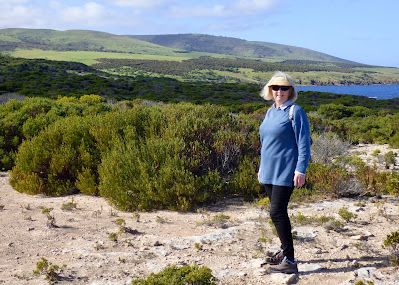On a gloriously sunny and windless day with barely a cloud to be seen in the sky we set off to do some more of the 1200 km Heysen Trail. We've been doing bits of it every now and again over the almost-five years we have lived on the Fleurieu Peninsula. This time, we decided to start at the very beginning, which, as we all know, is a very good place to start.
The track begins at Cape Jervis on the very tip of the peninsula, just behind the ferry terminal for Kangaroo Island ferries. Off we went feeling energised and looking forward to what lay ahead.
This first stage was a 4km trek to Fisheries Beach. The path was fairly narrow but meandered along the coast, providing us with lots of scenic variety: open scrubland, dense over-our-head foliage we had to push through, loads of wildflowers, glimpses of the rocky shoreline, pristine white beaches, and toward the end of the walk, rolling green hills falling away to the ocean.
And not far off in the distance we could see the dim outline of Kangaroo Island, as seen in this next photo.
We spotted some lovely flowers. I know that's a lupin on the right, so I'm not sure that's a native.

And a pretty Monarch butterfly.
The path continued, sometimes in a straight line making for easy walking.
Every now and again it wended its way closer to the coastline where lichen-shrouded rocks contrasted with the blue of the ocean.
Or through thick vegetation.
Steve saw this rock and reckoned it looked like a whale surfacing. What do you think?????
After about 2kms of walking (more like strolling as we kept stopping to take photos as well as just to breathe the clean air), we spotted an old pine tree in the distance - an obvious non-native that must surely have been planted here.
The tree towered beside the remains of what might have been a small cottage. There was a brick fireplace and some stone foundations. What a view they had.
Down below on the beach I spied a man walking his dog, the first sighting of anyone other than ourselves.
The path and surrounding land was now very limestoney and we had to be careful as we picked our way over the small rocks that jutted out of the track ready to trip the unwary. Not us though!
We were nearing the end of this part of the walk so stopped for a breather before turning around and heading back. It was a great spot with the hills in the distance and the peaceful bay below.
We retraced our steps, stopping every now and again to take more photos, and spotted the Kangaroo Island ferry on its return journey back from the island.
We were looking for the beach we had noticed on the way out that we thought would be perfect for a picnic lunch. And there it was. We picked our way down a sort-of-path.
Steve took off looking for more photo opportunities.
I decided to be a bit creative with reflections and sand patterns.
We tumbled into the car after our almost-8 km walk and I'm not sure whether we spoke to one another for the entire drive back home. We were utterly tired but felt happy, peaceful and content - and that's something to be thankful for in these days of uncertainty and lockdowns.







































